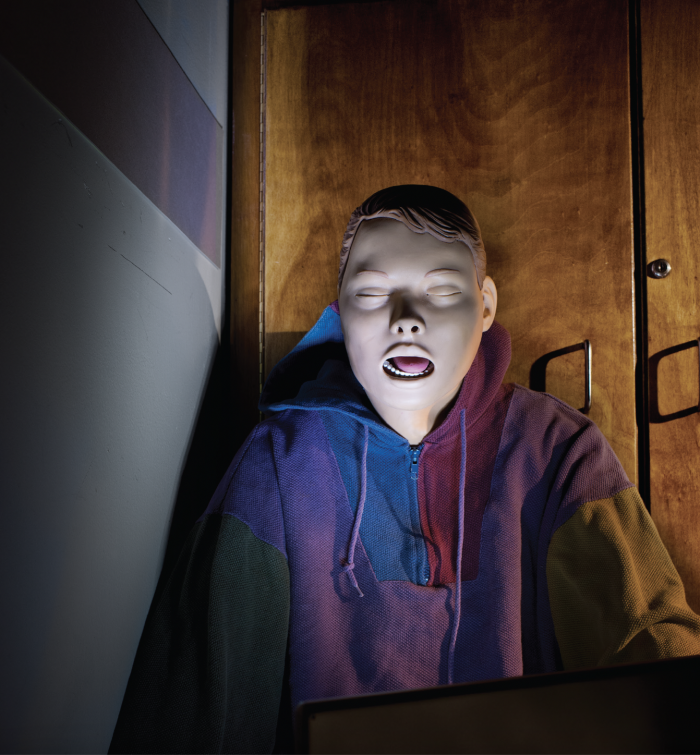Over four decades, Laurie Simmons has written an innovative and visually engrossing photographic story. With her new work on view at the Arnold & Marie Schwartz Gallery Met, she adds an entirely new chapter. Two Boys, a set of four photographs displayed in tandem with the North American premiere of Nico Muhly’s opera of the same name, presents not only a vision of the internal and communal traumas of the internet age, but also Simmons’s ever-expanding relationship to photographic practice.
Long admired for her commitment to both conceptual and formal rigor, Simmons has addressed a myriad of historical, social, and aesthetic phenomena, all through adroitly maneuvered lenses. Simmons’s projects include objects on legs, ventriloquist’s dummies, impossibly manicured interior scenes, and a musical featuring a chorus of melancholic puppets, all of which reflect her desire to communicate impossibilities, despite the sincerest dreams and prayers that remain with us from childhood. These themes, rendered in films, installations, and photographs, maintain intensely personal, but always relatable, underpinnings made tangible by surrogates – surrogates for human beings, for love, for loss.
In the 2009-2011 series, The Love Doll, for example, we find ourselves forging an emotional connection with a pair of high-end Japanese sex dolls. A similar operation is at play in Simmons’s earlier work, wherein we meet confined housewives and wandering tourists, dancing cameras and steely-eyed cowboy action figures. Simmons’s photographs recall childhood nights under the covers with our eyes squeezed shut, longing desperately for the acrobatics of the imagination to become real. Finding friends or lovers was so much simpler in our youth; toys do not have the capacity for rejection. We begin to wonder about the nature of the human body and the constantly shifting realm of memory, thereby jettisoning us into an indeterminate world fashioned by the camera and gestated in the mind. Simmons has said of her cast of characters, “Now I think it is important to address their inner lives. What is making them put one foot in front of the other?” (1) The answer only becomes more mysterious and complex with time.
What can be said for the medical dummies of Two Boys, who normally live quiet, unassuming lives in Brooklyn’s Lutheran Medical Center? Valued entirely for their utility, no one wants to hear their stories. They are harbingers of sickness that offer no entertainment or distraction, no glitz or artifice. Likewise, the paralyzing realism Simmons offers is so palpable, so unsettlingly tactile, that the photographs merge with a reality uncannily similar to our own. (2) Whether in the sheen of the boys’ skin or the pulsing void of the hospital floor, the viewer encounters details that paradoxically expose and conceal the role of the camera. It is here that Simmons offers an evaluation of the past using contemporary images; indeed, the history of photography itself becomes her focus. “The moment I picked up a camera,” Simmons remembers, “I felt that I had a responsibility to know what had happened in the past, so I immersed myself in the history, saw and read everything I could, and you know what? It didn’t take that long.” (3) The past of which she speaks is marked by the precariousness of her chosen craft. For most of its infancy and adolescence, the photograph was as lifeless and utilitarian as these dummies. In fact, it was not until the late 20th century that conceptual photography became the revered art historical staple it is today, a transition that Simmons, among others, spearheaded.
Two Boys could thus be said to contain this history. By elevating the medical dummies from tools to conceptual entities, while retaining their basic function as material objects through unflinching realism, Simmons reenacts the transformation of photography. She illustrates the very foundation of the photographic process, an unpredictable amalgam of technical, subjective, and universal factors. Perhaps she is equally interested in the “inner life” of the photograph as she is in that of her subjects. Simmons now presents us with the antonym of much of her previous work, and, in doing so, questions established narratives not only of her career, but also of photography as an art historical category. What results is a complex deepening of our relationship to the photograph, a love affair that Simmons perennially rekindles with formidable vigor.
(1) Simmons, Laurie. Laurie Simmons: Interviewed by Sarah Charlesworth. New York City: A.R.T. Press and Distributed Art Publishers, 1994.
(2) I owe this point to Mary Simpson, who initially noted the astonishing details in these photographs.
(3) Simmons, Laurie and Marvin Heiferman. “Laurie Simmons and Marvin Heiferman.” Art in America, 3 April 2009.
